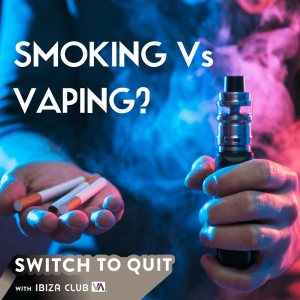VAPING Vs SMOKING?
We’re often asked if Vaping is ‘better’ than smoking. Better is a strange word to use in any sentence containing smoking, but in this instance ‘better’ is the right word to use. YES, vaping is better for you than smoking, but do you know why?
Vaping has been around a while now, but there’s still so much confusion surrounding the facts of vaping and sadly, some smokers have resisted switching to vaping believing that it isn’t safer than smoking. Let’s clear this up once and for all.
VAPING IS 95% LESS HARMFUL THAN SMOKING! 1
Why? Well, it’s all about the toxins. There are approximately 600 ingredients in cigarettes. When burned, cigarettes create more than 7,000 chemicals. At least 69 of these chemicals are known to cause cancer, and many are toxic.
Public Health England (PHE) found that while vaping is not entirely risk free, it is 95% less harmful than smoking, due mostly to the absence of smoke as the chemicals in e-liquids are heated, not burned.1
Here are just a few of the ingredients found in combustible tobacco products, aka cigarettes:3
- Acetone—found in nail polish remover
- Acetic acid—an ingredient in hair dye
- Ammonia—a common household cleaner
- Arsenic—used in rat poison
- Benzene—found in rubber cement and gasoline
- Butane—used in lighter fluid
- Cadmium—active component in battery acid
- Carbon monoxide—released in car exhaust fumes
- Formaldehyde—embalming fluid
- Hexamine—found in barbecue lighter fluid
- Lead—used in batteries
- Naphthalene—an ingredient in mothballs
- Methanol—a main component in rocket fuel
- Tar—material for paving roads
- Toluene—used to manufacture paint
The main difference between vaping and smoking is heat vs burning. The ingredients in an e-liquid are merely heated and as such don’t change state in the same way as the ingredients in tobacco do when they are burned. While it is known that vapour can include toxins, they appear in tiny quantities and have an incredibly short life span.
Vaping produces an aerosol cloud, which consists of fine particles, it is often confused with water vapour as it looks like clouds of steam (it does contain H2O, but it isn’t considered to be water vapour).
The aerosol cloud contains particles of material that have been transformed by the process of heating. The three core ingredients of e-liquid will be converted into different ratios of chemicals depending on the ingredients used. Owing to the tiny amount of toxins (so small, even the most sophisticated laboratories struggle to measure them) found in the vapour, coupled with the short life of the vapour, it also poses no risk to those around us – passive vaping isn’t a thing. The same cannot be said of smoking, with passive smoking known to have many serious side effects for people in close proximity to the smoker.
VAPING IS RECOGNISED BY THE NHS AS AN EFFECTIVE QUITTING TOOL2
When it comes to quitting smoking there are no easy choices, no matter what you do it’s going to be a tough road. But vaping can help you get there. Not only is it 95% less harmful than smoking1 it also helps you manage your cravings and keep hold of those hard to ditch rituals.
Switching to vaping instantly reduces the stress on your body and, surprisingly, your body will begin to heal very quickly. But it isn’t just about the massive difference in harm between cigarettes and vaping, it’s all about managing cravings.
Nicotine is not harmful, it’s addictive, but not harmful to your body.4 Which often comes as a huge surprise to smokers, who mistakenly believe that Nicotine is one of the ‘deadly’ ingredients in cigarettes. It is the burning of tobacco and the added chemicals that make smoking so toxic – elements change state when they are burned and that amplifies their impact on the body. When vaped Nicotine is NOT harmful when vaped as it is heated rather than burned. This allows you to maintain your ‘habit’ without the harm of smoking. You control your Nicotine levels, you can vape at the same times you would smoke, all the while quitting smoking.
Public Health England conducted a study of smokers engaged in quitting smoking with the NHS quitting services and they found that smokers were more than twice as likely to quit for good when using an e-cigarette combined with behavioural support. Cold turkey doesn’t work, but with vaping there’s no need to subject yourself to the agony of a hard stop and the inevitable withdrawal.
Our Switch to Quit programme is based on the NHS programme of behavioural support, but it goes a step further giving guidance on which equipment to purchase and ‘how to’ guidance on vaping.
If you have more questions about the differences between smoking and vaping head over to our FAQ area for more information and resources to help you make the decision to quit a little easier.
QUIT FOR GOOD, MAKE THE SWITCH TO VAPING.
References
References
- McNeill, A. et al. Evidence review of e- cigarettes and heated tobacco products 2018. A report commissioned by Public Health England (2018).
- Andy McEwen and Hayden McRobbie, Electronic cigarettes: A briefing for stop smoking services, National Centre for Smoking Cessation and Training (NCSCT) in association with Public Health England (2016)
- Long-term effects of inhaled Nicotine. Waldum HL (et al), study for Department of Medicine, University Hospital, Tronheim, Norway. (1996)

